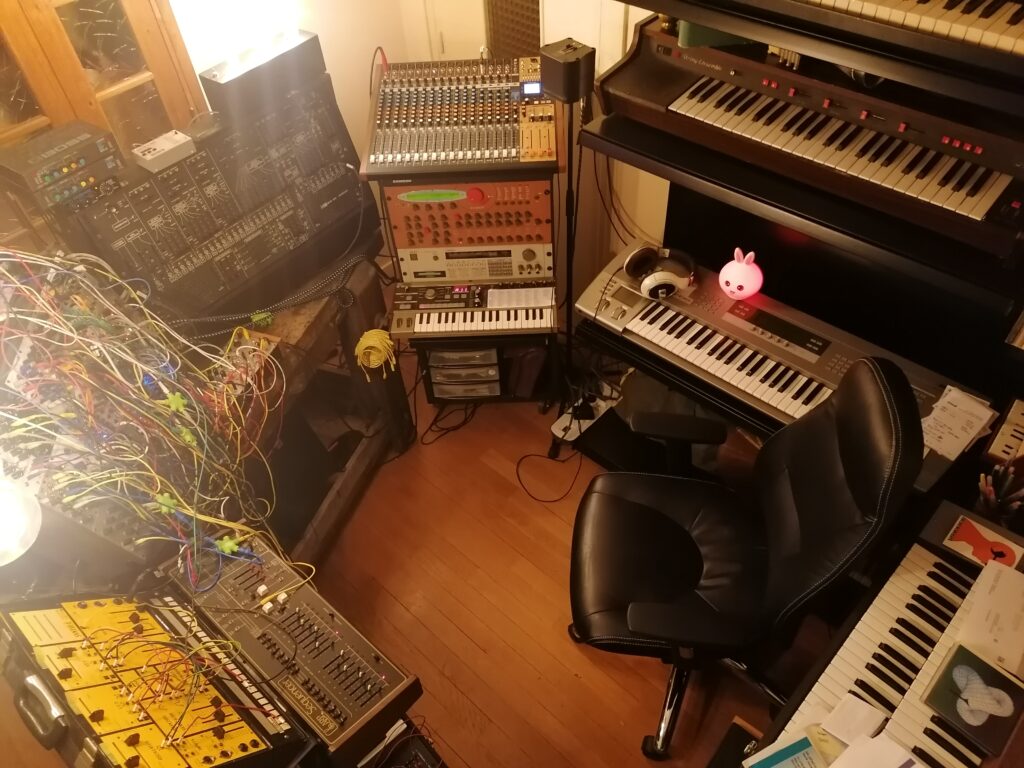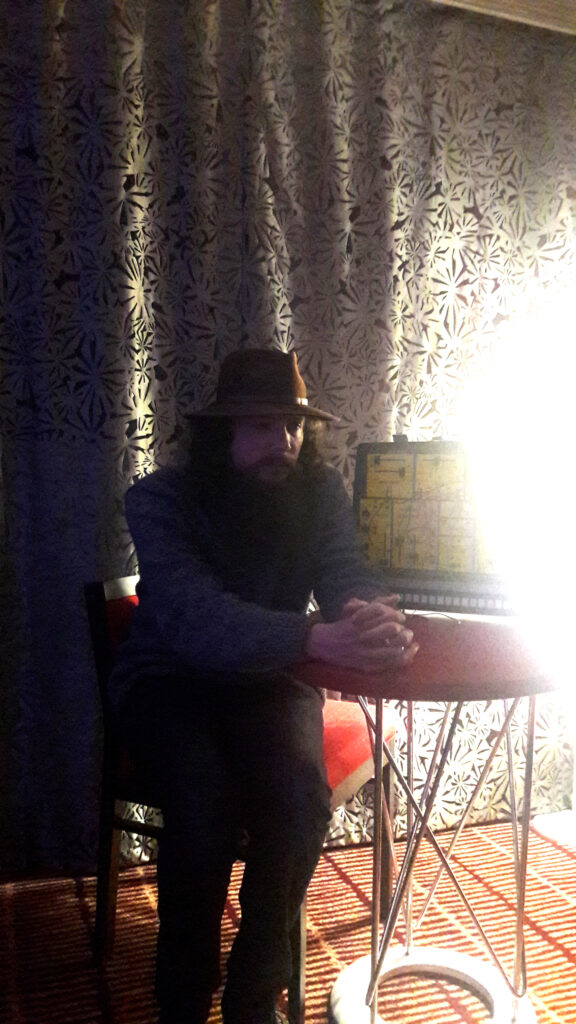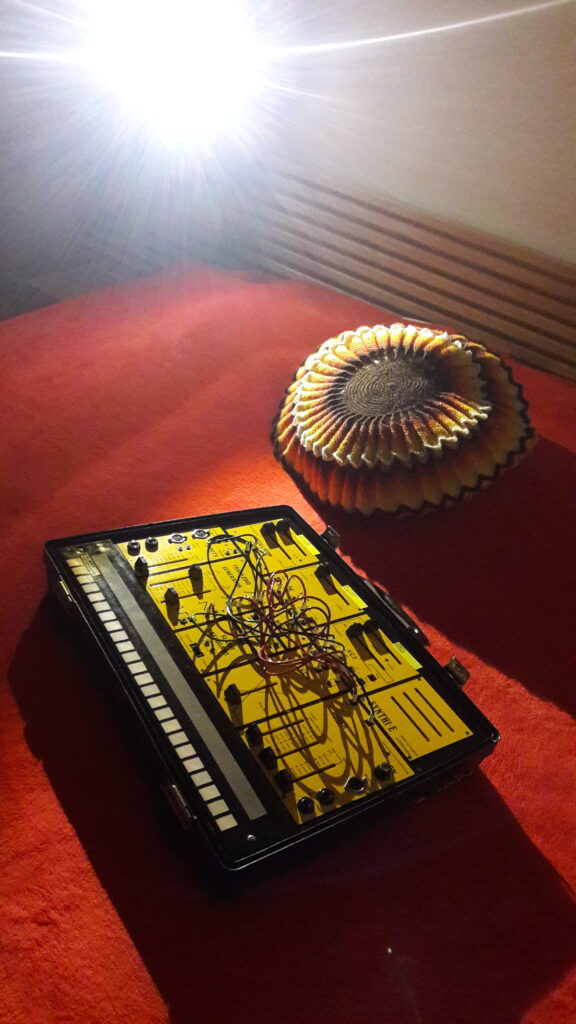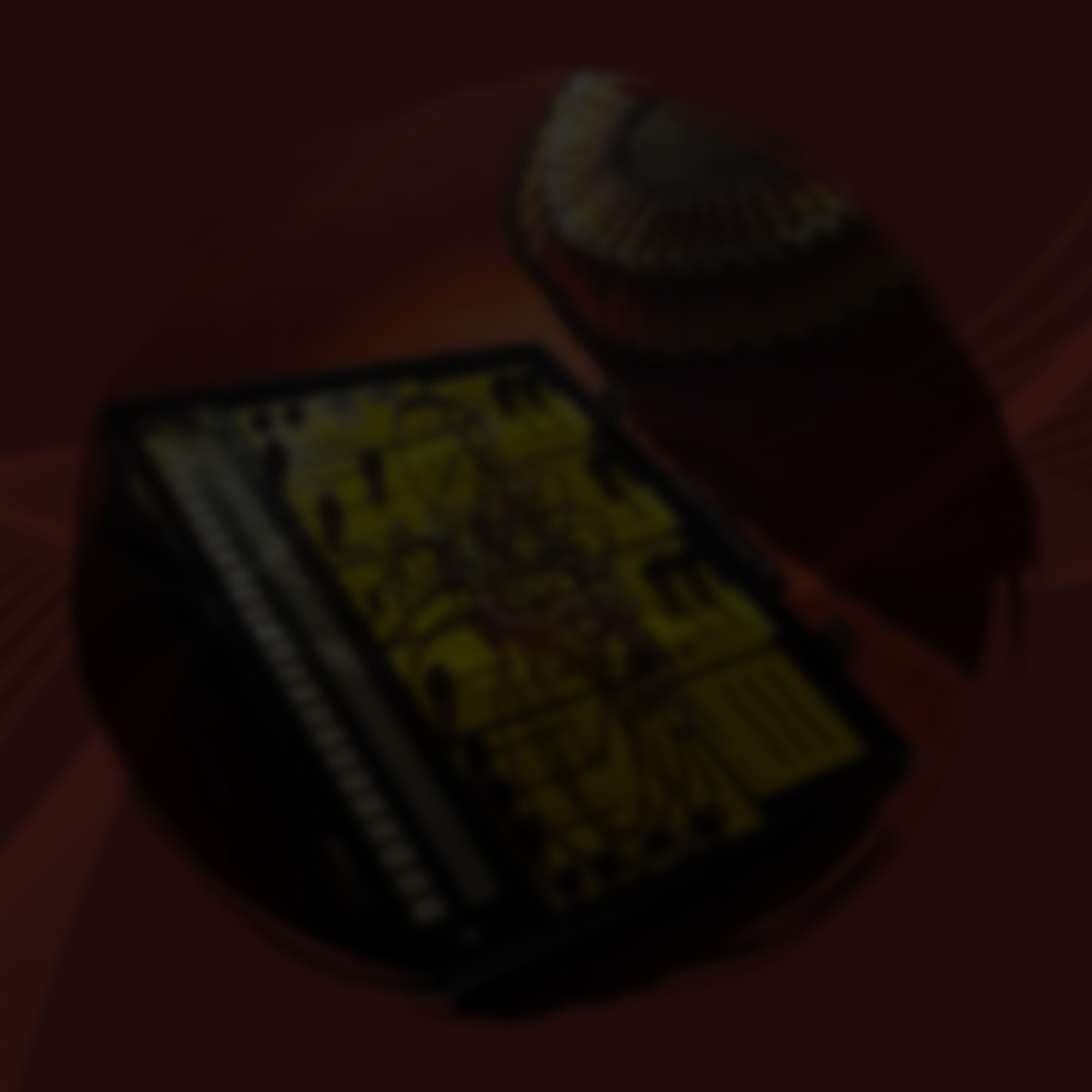Julien Palomo lives in Paris and likes to be discreet even if he has been active in our Experimental scenes for quite some time now… Founder of the label Improvising Beings devoted to improvisation, provoking encounters and, at the same time, paying homage to an underestimated part of the radical musics of the twentieth and twenty-first centuries, especially Free Jazz but not only…
Julien himself fluently speaking the language of EMS and ARP as you can hear listening to our session…
Would you please give a resumé of your musical activities? Musical biography?
I tried to enroll in the cello class of my small town conservatory, but it was crammed. Instead I was proposed harp. Why not? I mistreated the poor instrument until the ripe age of 17. Yet my father turned me on to Coltrane and Pierre Henry when I was 12. Soon I was banging on the harp’s soundboard through a toy reverb. I went as far as giving a cassette of this utter crap to Pierre Henry when I was 15 and he sent me a nice note encouraging me to do my own thing, follow my intuition and nothing else.
At 20 I was into Free Jazz. I wasn’t into playing it, or anything, I thought one day I’d be a writer. But I enjoyed helping organizers on the local scene. Friendships with the artists I helped book or whose gigs I attended frequently prompted me to start a label in 2009, Improvising Beings, whose vague purpose was to document as much as possible of the current music of the early generation of artists who developped Free Jazz in the 1960s. I favored CD, an aesthetic and technical choice which killed off the label after 70 releases in 2017.
In the meantime, some of the label’s mainstays like Sonny Simmons, François Tusques and Alan Silva, kindly urged me to play music myself. Tusques offered me the old Kurzweil K1000 and Akai S950 that were gathering dust in his studio, Silva showed me the basics, Simmons used me on his most experimental records when he wanted to explore sounds he couldn’t get with trained jazz musicians. By 2011 I started a band, Other Matter, with an old friend who collected Fre Jazz records like me, electric guitarist Michel Kristof. We grew up as instrumentists together, nearly from scratch, and his energy and constant sonic challenges kept me playing when I often felt I should quit. We still soldier on as of 2020.
What have you been working on lately, and do you have any upcoming releases or performances?
I have performed infrequently – hardly ever, actually. And rather to give a hand to friends in the free improv/free noise realm, such as Makoto Sato who uses Other Matter from time to time, or american saxophonist Vinnie Paternostro, when he visits France. My personal music is a pure studio compositional process that involves a system too large for me to carry around.
Bulgarian label Mahorka will release my first solo cassette in the spring of 2020, two drones very akin to what is featured on this Modulisme session. I have more or less completed four records in 2018-2019 with old friends and mentors Mario Rechtern and Eric Zinman, master reedman Massimo Magee, and trombone player Henry Herteman. Those four projects explore the junctions between Free Jazz and modular synthesis. The difficulty is that this cross-over doesn’t appeal much to either the Free Jazz public, either the modular public. Expect Bandcamp/Soundcloud DIY releases this year. It’s a pity because they’re great records, well, maybe not my parts, but my comrades really shine on them. I have two « pure » electronic albums in the making, duets with Fabien Robbe (Britanny) and Autumn Altair (US) which are more rhytmic and/or industrial in nature.
How were you first acquainted to Modular Synthesis? When did that happen? When did you buy your first system?
I’m 42, I’m white, I’m French. The only valid answer to this question is: Jean-Michel Jarre, of course, when I was 10, because Oxygène was the album stores sold with the first CD players… I didn’t enjoy it much but wondered about the instruments listed – ARP 2600? VCS3? The sounds were cool. Jarre leading to Pink Floyd leading to Tangerine Dream, standard cursus honorum for a kid growing up in the 1990s when said kid wasn’t into hard rock.
My early acquaintance with Free Jazz and electro-acoustic music mercifully wiped away those influences, and I started to enjoy in earnest Kluster and Conrad Schnitzler, Musica Elletronica Viva, Bernard Parmegiani, Eliane Radigue (yes, Radigue, long before she was in fashion). So I was aware of « vintage synthesizers », by way of their various unorthodox uses, most of my life. But not much of their contemporary developments. When I returned to music in the late 2000s it was obvious I was hopeless as a pianist, and barely decent as a keyboardist, and again my old friends in Free Jazz, Tusques, Alan Silva and Burton Greene, rescued me when they showed me what their digital synths hid under the hood – programmation. I found the K1000 difficult and bought a MicroKorg, bingo.
I was also aware of the work of people who used modular in free improv, chiefly Jean-Marc Foussat and Richard Scott. All apologies to all talented people I discovered later, like the great Thomas Lehn. I got to work with Jean-Marc and had my first contact with a VCS3 and an AKS. It registered with me. Coincidently, I was laid off by my company. And it came with a check. A fat check. I bought the EMS Synthi E, odd choice, but it had that EMS vibe minus the intricacy. And when I felt confident enough with the basis of synthesis, then, partly influenced by Radigue’s sound, partly by various memories of Oxygène, Joe Zawinul, Herbie Hancock, Jon Snyder on Joe McPhee albums, Ken Elliott of Second Hand, I got an ARP 2600 and its sequencer. Eurorack came in 2017 when I was looking for ARP and EMS-related clones to enrich the palette of the E and 2600.

What was the effect of that discovery on your compositional process? On your existence?
The ARP 2600 fucking saved my life. I was in a dark place in 2016 and 2017, health issues, and for months at length I could barely walk out of my house. All I had to do was to master the 2600 at my bedside and learn synthesis in the process. It helped me keep my sanity together, and gave me a purpose. Ever since, I make sure I practice about 10 hours a week, more if I can.
Given my background in free improv, I had no compositional process at all, I put the emphasis in « conversational » skills with other artists. And when I started to take a keen interest in programming digital synthesizers, the idea was to create unexpected sounds, crazy presets that would balance my limited skills as a keyboard player. One tip of the finger and suddenly a micro composition of a few seconds unfolded… It wasn’t long until I realized that little tip would, with modular synthesizer, unleash a large-scale sonic catastrophe.
I have to credit Alan Silva again. As a double bass player, he was one of the very first, in 1963, to take jazz into « pure » improv, with no written material whatsoever. And later in 1969 to conduct large-scale orchestras of free improvisers. In the 1980s, he turned to synthesizer to get that orchestral « feel » without the need for 50 people in a room. He calls that the Orchestral Synthesizer: the workflow IS the instant composition. The instant composition IS the worklow. You can’t dissociate the two. You work in the moment with the two in mind. The preparation, well, that’s the patch sheet – it’s how many instruments I hear in the piece. I start to work on the timbres and textures. Even before I start a patch I hear very precisely in my head this or that sound. As I know my system well because I practice very hard, I know what my instruments and modules can do. Eventually (more often than not…), the patch sheet sets a few reference marks, determines a few events that will happen at some point during the performance of the piece, roughly: when that LFO or chaos curve has ran its course, when that sequencer goes one step further, etc. Nothing fancy, you see, very basic stuff. But very carefully planned, I insist. Then of course as it starts to unfold, I have my timbres in place, they are neatly identified on the final mixer/panner, I know this or that dramatic event will happen at this or that point… and it’s up to me to make the system alive with the remaining modulation sources I have left aside in less « constrained » states within the global picture. They leave me room to improvise. Again I don’t think this is very revolutionnary. Modular synthesis helps me create an orchestral deterministic frame, and then I give life to all the little people in my little orchestra, as if I were several acoustic instruments. Put that way it’s a little creepy, right?
Quite often modularists are in need for more, their hunger for new modules is never satisfied? How do you explain that?
Given what I just said, how could you refrain from adding new voices to your orchestra? Instruments that you didn’t even know existed in the first place? When Beethoven felt this part needed an oboe, he wouldn’t refrain to write down a oboe part. If you look at synthesizers, modular synthesizers, as instruments, there’s no way you can understand that need. Most instrument players will indeed stay within the confine of their instrument. It’s physically there, in front of them, it can’t suddenly magically grow a 7th string, a 92nd key, a second mouthpiece… So those instrument players will often give that look to synthesists, poor guy, you’re crazy. But if you put back synthesizer in its historical context of portable studio, one-instrumentist orchestra, the second embouchure and 7th string is possible. It demands the second embouchure and 7th strings. And it feels good to be God for a minute, divising sounds that defy acoustics of instruments of the past.
Of course this is all sheer hybris, and begs to be preyed on by gear manufacturers and sellers, who have become expert in selling you the thousandth iteration of sounds and functions you don’t need in the first place – don’t need at all. Based on assumptions of what your personal orchestra should sound like, which is a polite way to say something very rude: « what music should sound like ». Your music.
Would you please describe the system you used to create the music for us? Can you outline how you patched and performed your Modulisme session?
My current system has been pretty stable for two years. It is comprised of a core of Eurorack modules, the ARP 2600 and ARP 1601 Sequencer, an EMS Synthi E, a Korg Z1, a Waldorf Microwave XT, an Akai S950. The digital synthesizers are strictly controlled by the Eurorack via a Kenton CV to Midi, I may use the keys once in a while. I tend to run the whole system through the ARP 2600’s built-in spring verb. Outboard I have old, colourful effects (a tad bit dirty): Dynacord VRS-23 and DRS-78, Alesis Microverb (dirt), Boss RPS-10 (more dirt). I record directly in a Tascam Model 24. I don’t use the computer during the recording process. It comes later if I need a bit of editing (the less, the better), compression, or if a composition requests heavy layering of several recorded performances – « tape splicing ».
I have two eurorack cases. Ian Fritz chaos circuits and Mystic Circuits ANA are featured in almost all my works, they are great compositional tools. I favor Nonlinear Circuits and Epoch Benjolin, conflicting stuff that add spice. Extra oscillators: Liivatera Through Zero, CG XR22, NLC ‘I can’t believe it’s not a VCO’, Bubblesound uLFO, Noise Reap Bermuda. Logic modules, weird logic modules also, weird clock (Arrhythmia by Plankton Electronics, a clock sequencer, how cool), ring mods, half wave rectifiers, two mix sequencers to distribute modulation sources, a great idea derived from the workflow of the ARP 2500. And I stuffed a Moog DFAM in the midst of all this. Final stage, the WMD Performance Mixer.
Describing the patch for these works is a nightmare. I’m the kind that uses every in and out available, with outboard multiples flying around. Of the large drone piece, Swollen Music, which is part of a 7 hours cycle of compositions I just finished, I can state as much: 3 sequences collide by way of logic computations of their pitches, they are modulated by inter-related chaos curves, and driven by 3 different clocks, inter-related too, which may or may not coincide, which is determined by carefully timed LFOs. There is a complex net of feedback patching, cross-modulations – you can’t touch anything without affecting nearly all available parameters of sound and modulation. I like chain-reactions that demand intervention to reach a new equilibrium. Transitions. I have learned to love them in Eliane Radigue. But then suddenly, an event occurs. Radigue would let one through the stasis in every of her piece, beautiful… Anyway, as much as I love the sound of raw synthesizer, I think I always make sure my work won’t sound « modular in essence ». It’s… music. I hope some of the timbres and textures can confuse people on to what their origin is. Hence also the inclusion of the digital synthesizers, the Waldorf Microwave and Korg Z1, who are anyway very modular in their workflow, and can produce sounds uncannily reminiscent of acoustic instruments, or thoroughly unrecognizable. But I don’t use them in the foreground, they’re part of the swarming of things belowe the thick frame of the piece… I also created an extra layer of ARP 2600, sampled in the Akai S950. By the way, all the pieces for the session are performed in real time. No edits (not even the fades). I thought that was the purpose of a « session ». Sometimes I enjoy recording zillion hours of the system to compose more carefully, lots of copy and paste.
What would be the system you are dreaming of?
I’m not gear-oriented because I’m sound-oriented and have always had a pretty clear idea of what I wanted to hear and of the worklow. But alright, I would love to have an ARP 2500. Massive, self-sufficient. I have a thing for self-contained instruments, I could fancy a Hordijk or Wiard system. I could cope with a second 2600, by default. But actually – I’ve had this kind of money once in my life, pure luck, I am grateful for this and now that’s it. It won’t happen again and I yet I have something to express. It’s in my nature to be contemplative and avoid temptation. Sometimes I have an idea – this or that function – I spend hours watching demos and end up finding a way around with what I have. Next ? I wouldn’t mind more esoteric stuff from Nonlinear Circuits, I must confess. If I hear something in my head that demands it. I don’t try things, I envision them.

Are you feeling close to some other contemporary Modularists? Which ones?Which pioneers in Modularism influenced you and why?
I am pretty ignorant of the developments in electronic music since… the 1970s. I missed all branches of EDM even though I’m their contemporary. I have been absorbing loads and loads of Free Jazz, electro-acoustic and noise music in 30 years, I have pursued other musical interests as an organizer and producer, and only recently have found the headspace to focus on « modular music ». Reason of this ignorance is of course too that I didn’t hear many modularists in my active Free Jazz years other than the few I mentioned already. Let’s say that in the closing years of the label, I always hoped I’d make enough money to branch out into electronic improv. Richard Scott, Cesario Fa and Jean-Marc Foussat had recorded som beautiful solo albums for me. The label collapsed and it couldn’t materialize, much to my dismay, as I feel the picture isn’t complete… Those names give you an indication where my head’s at. I should mention Phil Durrant, Kurt Liedwart, Susan Drone, Ronald Pellegrino and Doug Lynner of Synapse whom I have met thanks to Facebook groups: all widely different, not even close to my own music, but I follow what they do. There’s still something uncanny on the corner once you dip your toe in the waters of strange music, I still consider myself in my learning years, and internet series of releases from Data Cult Audio, Modulisme, or Unexplained Sounds keep me up-to-date more than enough. Maybe because I miss my years as a producer, I tend to favor listening to music that is within social networks’ reach. Which has opened me to other forms of synthesizer music, not necessarily modular: I listen to Forest Fang, David Morley and Robert Rich a lot. I am slowly opening to ambient.
Pioneers… Eliane Radigue, Lauren Spiegel and Pauline Oliveiros (her raw Buchla 100 experiments!)… Conrad Schnitzler (raw again)… Richard Teitelbaum… André Stordeur… Paul Bley (yes, the Synthesizer Show, he had a 2500 on stage)… Parmegiani who didn’t shy away from his AKS… I absorbed all this at a time when modular synthesizer wasn’t a prime interest of mine. Understanding came later. As you can see they are mostly people who balance composition and instrumental prowess (making the damn things work when they were an idea fresh from the bench). Part tech pioneers, part craft. I will never have the chance to pioneer any kind of new technology (I admire computer skills in many a contemporary, but can’t wrap my head around them, you noticed I haven’t a single mini-computer in my system), but the idea of honest craft inspires me. When I feel frustrated with the outcome of my research, a bit of their work gives me strength to work even harder.
Any advice you could share for those willing to start or develop their “Modulisme”?
I’m still in the prime of my learning years. I’d feel very foolish giving anybody advice. Maybe, in the light of my answer to your question about gear… Think about your music first and then try to get what modules fit the music you want to create. And learn them like you’d learn any other instrument. Don’t fall for the « instant techno », « instant ORTF » kits. Be a musician before you become a synthesist. Don’t consume, create. How naive of me, innit?

